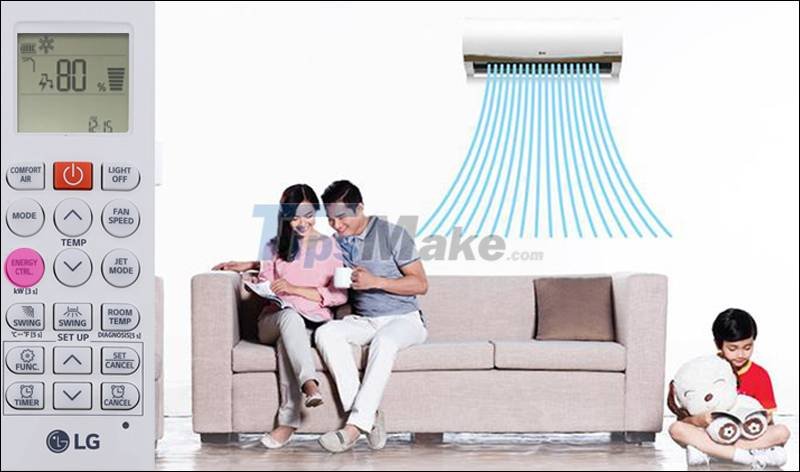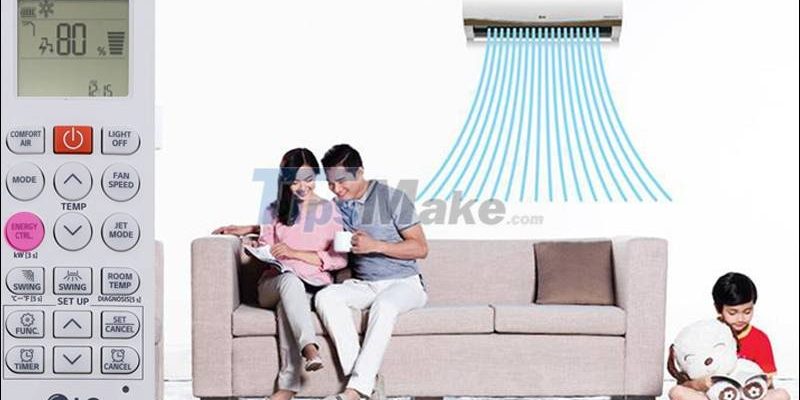
Before you wield that remote and attempt any code-punching magic, let’s talk about what kind of LG AC remote you’re working with. Some are those classic “pebble-style” infrared remotes—point-and-click, easy to misplace, but generally fuss-free. Others might be fancier, with WiFi, LCD screens, or extra “smart” features. No matter the model, the process of connecting or pairing it with your new LG air conditioning unit usually follows a similar playbook. The tricky part? The instructions often read like they were designed to test your patience. Don’t worry, I promise it’s less confusing than assembling IKEA furniture.
Understanding How LG AC Remotes Work
The first myth to bust is the idea that all AC remotes are universal or can magically predict what device you’re trying to control. Here’s the thing: your LG AC remote sends out *infrared* signals—think of it like a flashlight beaming a secret pattern of blinks that only your air conditioner understands. The remote and the unit need to “speak the same language” or nothing happens. Most LG remotes are designed to work straight out of the box with specific models, but sometimes they need a gentle nudge to recognize each other.
If your LG remote has batteries and isn’t working, a dead battery is occasionally the only villain here. But if you’re trying to pair a brand-new remote or sync after a reset, you’ll need to make sure both devices are ready to “talk.” Some units have a basic code-pairing process, while others synchronize automatically when the batteries are inserted and buttons are pressed—sort of a remote version of a handshake. Funny enough, it’s a bit like two friends waving across a crowded room before finally locking eyes.
Not all LG air conditioners use the same pairing routine. If you’re using a universal remote or a smart remote (say, from a third-party brand), you may need a code or two. LG’s own remotes are much more plug-and-play, but sometimes a “reset” fixes weird bugs. Manuals love glossing over these details, but trust me—when you know what’s supposed to happen, it’s a lot less nerve-wracking.
Preparing To Pair: What You’ll Need
Before you get started, it’s good to gather your materials—kind of like prepping ingredients before you start baking. The basics? You’ll want your LG air conditioning unit powered up and plugged in, your remote with *fresh batteries*, and a clear line of sight between the remote and the unit (no obstacles, no weird reflections, just you and your appliances making eye contact).
- LG AC unit: Make sure it’s switched on and ready for the remote’s signal.
- Remote control: Insert new batteries—even if you’re convinced the old ones still work. Weak batteries can cause all sorts of weird pairing issues.
- User manual: These little booklets can look boring, but sometimes they hide important pairing codes or steps. If you’ve lost yours, LG’s website usually has digital copies—just type in your model number.
If you’re using a universal remote, keep the code list handy. LG-branded remotes generally *do not* require codes unless you’re pairing across different series or with older units. One last thing—not every living room is set up for remote success. Make sure you aren’t battling sunlight glare, electronic interference, or that wobbly ceiling fan with a personal vendetta against wireless signals.
The Standard Pairing Process For LG AC Remotes
Here comes the fun part. Honestly, pairing your LG AC remote is mostly a matter of pressing the right buttons in the correct order. For most models, here’s how it usually works:
- Stand about five feet from your air conditioning unit. The remote’s sensor works best at this range—think of it like tossing a paper airplane.
- Make sure the AC is powered on (the display on the AC unit should light up).
- With the remote loaded with new batteries, point it straight at the front panel of your LG AC unit—don’t angle it or bounce it off walls. Direct line of sight is key here.
- Press the Power button. Sometimes, the unit will immediately beep, flash, or display a symbol—congratulations, you’re paired!
If nothing happens, don’t panic. Some models require you to press a specific Set or Mode button simultaneously with the Power button. Hold these for a few seconds until you see the AC unit respond (a beep, a click, or the display changing is usually a good sign). It’s almost like teaching your dog a new trick—sometimes you need to repeat the command a couple of times.
If you’re stuck, peek at your user manual for the precise combination. With most LG models, pairing is truly just a matter of pressing Power and waiting for the AC to respond. If you still get radio silence, it might be time to try a reset.
Resetting The Remote And AC Unit
Let me be real: electronics love to throw tantrums. Sometimes, neither the remote nor the AC wants to play ball, and everything feels frozen. This is where the reset button comes in handy—it’s like a gentle “let’s try this again, shall we?” for your devices.
For most LG remotes, resetting is simple:
- Remove the batteries from the remote.
- Wait about 30 seconds (I usually use this time to check if there’s cereal under the sofa).
- Re-insert the batteries and make sure they’re seated properly.
On some remotes, there’s a tiny “Reset” hole—use a paperclip to press it in for 2-3 seconds.
If you think the AC unit itself is being stubborn, you can reset it by unplugging it from the wall for a minute, then plugging it back in. This gives the internal memory a chance to clear out any bad vibes. Pair the remote again by pressing the Power button and see if the unit finally responds.
If you’ve ever fixed a phone by turning it off and on again, you already get the basic idea. Resetting isn’t just for computers—most modern appliances love a good reboot.
Troubleshooting Common Pairing Problems
Pairing your LG AC remote isn’t always smooth sailing. Sometimes, you’ll press every button in sight—and still hear crickets. Let’s talk about the usual suspects behind these problems.
First, always check the *batteries*. Even brand-new batteries can be duds or inserted incorrectly. Make sure the positive and negative ends match the markings. And yes, sometimes it really is that simple.
If you’re using a universal remote, make sure you’ve entered the correct code for your LG model. There’s usually a list in the remote’s booklet or on the manufacturer’s website. If you try the wrong code, the AC won’t react at all—it’s like calling someone by the wrong name at a party.
Sunlight, fluorescent lights, or even glass coffee tables can mess with infrared signals. Try pairing in the evening, or move any objects out of the remote’s path. If the AC only works at certain angles or distances, the remote’s sensor may be dirty—wipe both the remote’s and the unit’s sensor windows with a dry cloth.
Sometimes, the AC’s “child lock” or “sleep” settings can block remote commands. Double-check the display for any unusual icons, and consult the manual to disable these features before you keep troubleshooting.
Pairing A Universal Remote With LG AC
Got a universal remote instead of the LG-branded one? No biggie—it just means you have a couple of extra steps. Universal remotes work by mimicking the signals of the brand’s remote, using a *code* you punch in during setup. Here’s a typical process:
- Find the pairing code for LG AC units. (Look in your remote’s code book or search online.)
- Press and hold the Set or Code button on the universal remote until the LED blinks.
- Enter the LG code using the number buttons.
- Point the remote at the AC unit and press Power. If the unit responds, you’re set! If not, try the next code on the list.
Remember, some universal remotes only support basic commands—Power, Temperature, and Fan. Advanced features like Sleep, Timer, or Swing may not work unless you have a higher-end model.
If you’re debating between a universal and a branded remote, here’s my two cents: branded remotes are easier to set up and usually give you full access to features. Universal remotes win on convenience—good if you’re juggling lots of gadgets—but they sometimes lack the finesse for fancier LG AC settings.
Advanced Features And “Smart” LG Remotes
So, you’ve got a fancy LG AC with a WiFi-enabled or “smart” remote? Welcome to the big leagues—pairing gets a modern twist. These remotes often use Bluetooth or WiFi instead of infrared, which means you can control your AC from a smartphone or even sync it with voice assistants like Alexa or Google Home.
For these models, pairing often involves:
- Downloading the LG ThinQ app from your app store.
- Creating an account and following the in-app instructions to connect your remote and AC unit to your WiFi network.
- The app will walk you through pairing—usually by pressing a specific button on your remote or AC until an LED blinks. After that, you can control everything right from your phone.
Sometimes, the app asks for the AC’s serial number (located on the side or back of the unit). Honestly, these setups feel more like installing a new phone than a remote control, but the payoff is worth it—remote access, scheduling, and even energy reports right at your fingertips.
When Your Remote Won’t Pair: Next Steps
If you’ve run through all the pairing, reset, and troubleshooting steps, but your LG AC remote still won’t pair, you might be facing a hardware issue. Remotes can be surprisingly delicate—one accidental drop off the couch, and suddenly the infrared LED is toast. Likewise, if your AC unit’s sensor got bumped, dusty, or zapped in a power surge, it might not respond even to a perfectly good remote.
If possible, test your remote on another LG AC unit (like at a friend’s place or the store). Or, try a different remote (universal or LG) on your unit. If only one part works, you’ve found the culprit.
Many LG service centers offer remote testing and sensor repair. It’s usually cheaper than buying a whole new AC. Meanwhile, some models have *manual controls*—hidden buttons on the unit itself. Check if you can still operate the basic functions until you get your remote sorted out.
Technology fails us all sometimes. What matters is having backup options and never letting a stubborn remote ruin your cool (literally).
Final Thoughts: Stay Cool And Pair On
Pairing your LG AC remote with a new unit sounds intimidating, but it all comes down to matching a few signals and making sure both devices are ready to “talk.” Whether you’re working with the standard LG remote, braving a universal one, or exploring the world of smart controls, the key is patience, fresh batteries, and the willingness to try a reset or two.
If you run into hiccups (and let’s be real, we all do), remember that most issues trace back to the basics—line of sight, correct codes, or just a flaky battery. The good news? Once your remote is paired, you’re back to the simple joys of perfect indoor temperatures with the press of a button. And hey, if pairing feels tricky the first time, just think of it as a quirky little handshake between you and your tech. Keep that remote handy—your living room comfort depends on it!
